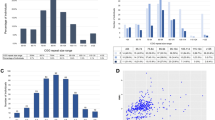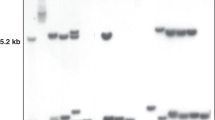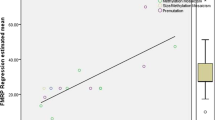Abstract
Nearly all cases of fragile X syndrome result from expansion of a CGG trinucleotide repeat found in the 5′ untranslated portion of the FMR1 gene1. Methylation of the expanded repeats correlates with down-regulation of transcription of FMR1; thus fragile X syndrome is postulated to be due to a loss of function of the FMR1 gene product2–5, and this has been demonstrated at the protein level6,7. However, the nature of the mutation offers the possibility of methylation spreading to adjacent genes with consequent loss of expression and contribution to the phenotype. Deletions of FMR1 and flanking sequence (some of substantial size) have been reported in patients with phenotypes consistent with a diagnosis of fragile X syndrome8–15; however, none is strictly intragenic. We report here the identification of two different intragenic loss of function mutations in FMR1: a single de novo nucleotide deletion in a young male patient (IJ) and an inherited two basepair change in an adult male (SD), each with classical features of fragile X syndrome.
This is a preview of subscription content, access via your institution
Access options
Subscribe to this journal
Receive 12 print issues and online access
$209.00 per year
only $17.42 per issue
Buy this article
- Purchase on Springer Link
- Instant access to full article PDF
Prices may be subject to local taxes which are calculated during checkout
Similar content being viewed by others
References
Warren, S.T. & Nelson, D.L. Advances in molecular analysis of fragile X syndrome. J. Am. med. Assoc. 271, 536–542 (1994).
Hornstra, I.K., Nelson, D.L., Warren, S.T. & Yang, T.P. High resolution methylation analysis of the FMR1 gene trinucleotide region in fragile X syndrome. Hum. molec. Genet. 2, 1659–1665 (1993).
Hansen, R.S., Gartler, S.M., Scott, C.R., Chen, S.-H. & Laird, C.D. Methylation analysis of CGG sites in the CpG island of the human FMR1 gene. Hum. molec. Genet. 1, 571–578 (1992).
Pieretti, M. et al. Absence of expression of the FMR-1 gene in fragile X syndrome. Cell 66, 817–822 (1991).
Sutcliffe, J.S. et al. DNA methylation represses FMR-1 transcription in fragile X syndrome. Hum. molec. Genet. 1, 397–400 (1992).
Verheij, C. et al. Characterization and localization of the FMR-1 gene product. Nature 363, 722–724 (1993).
Devys, D., Lutz, Y., Rouyer, N., Bellocq, J-P. & Mandel, J.-L. The FMR-1 protein is cytoplasmic, most abundant in neurons and appears normal in carriers of a fragile X premutation. Nature Genet. 4, 335–340 (1993).
Wöhrle, D. et al. A microdeletion of less than 250 kb, including the proximal part of the FMR-1 gene and the fragile-X site, in a male with the clinical phenotype of fragile-X syndrome. Am. J. hum. Genet. 51, 299–306 (1992).
Gedeon, A.K. et al. Fragile X syndrome without CCG amplification has an FMR1 deletion. Nature Genet. 1, 341–344 (1992).
Tarleton, J. et al. An extensive de novo deletion removing FMR1 in a patient with mental retardation and the fragile X syndrome phenotype. Hum. molec. Genet. 2, 1973–1974 (1993).
Trottier, Y., Imbert, G., Poustka, A., Fryns, J.-P. & Mandel, J.-L. Male with typical fragile X phenotype is deleted for part of the FMR1 gene and for about 100 kb of upstream region. Am. J. med. Genet. 51, 454–457 (1994).
Gu, Y., Lugenbeel, K.A., Vockley, J.G., Grody, W.W. & Nelson, D.L. Ade novo deletion in FMR1 in a patient with developmental delay. Hum. Mol. Genet. 3, 1705–1706 (1994).
Meijer, H. et al. A deletion of 1.6 kb proximal to the CGG repeat of the FMR1 gene causes the clinical phenotype of the fragile X syndrome. Hum. molec. Genet. 3, 615–620 (1994).
Hirst, M. et al. Two New Cases of FMR1 Deletion Associated with Mental Impairment. Am. J. Hum. Genet. 56, 67–74 (1995).
Quan, F. et al. An atypical case of fragile X syndrome caused by a deletion that includes the FMR1 gene. Am. J. Hum. Genet. 56, 1042–1051 (1995).
Ashley Jr, C.T., Wilkinson, K.D., Reines, D. & Warren, S.T. FMR1 protein contains conserved RNP-family domains and demonstrates selective RNA binding. Science 262, 563–566 (1993).
Siomi, H., Siomi, M.C., Nussbaum, R.L. & Dreyfuss, G. The protein product of the fragile X gene, FMR1, has characteristics of an RNA-binding protein. Cell 74, 291–298 (1993).
De Boulle, K. et al. A point mutation in the FMR-1 gene associated with fragile X mental retardation. Nature Genet. 3, 31–35 (1993).
Willems, P.J. Dynamic mutations hit double figures. Nature Genet. 8, 213–215 (1994).
Siomi, H., Choi, M., Siomi, M., Nussbaum, R. & Dreyfuss, G. Essential role for KH domains in RNA binding: impaired RNA binding by a mutation in the KH domains of FMR1 that causes fragile X syndrome. Cell 77, 33–39 (1994).
Bakker, C.E. et al. Fmr1 knockout mice: A model to study fragile X mental retardation. Cell 78, 23–33 (1994).
Keen, J., Lester, D., Inglehearn, C., Curtis, A. & Bhattacharya, S. Rapid detection of single-base mismatches as heteroduplexes on Hydrolink gels. Trends Genet. 7, (1991).
Neitzel, H. A routine method for the establishment of permanent growing lymphoblastoid cell lines. Hum. Genet. 73, 320–326 (1986).
Verkerk, A.J.M.H. et al. Alternative splicing in the fragile X gene FMR1. Hum. molec. Genet. 2, 399–404 (1993).
Author information
Authors and Affiliations
Rights and permissions
About this article
Cite this article
Lugenbeel, K., Peier, A., Carson, N. et al. Intragenic loss of function mutations demonstrate the primary role of FMR1 in fragile X syndrome. Nat Genet 10, 483–485 (1995). https://doi.org/10.1038/ng0895-483
Received:
Accepted:
Issue Date:
DOI: https://doi.org/10.1038/ng0895-483
This article is cited by
-
Role of FMRP in rapid antidepressant effects and synapse regulation
Molecular Psychiatry (2021)
-
Most Martin–Bell syndrome (FMR1-related disorder) Venezuelan patients did not show CGG expansion but instead display genetic heterogeneity
Journal of Human Genetics (2017)
-
Intragenic FMR1 disease-causing variants: a significant mutational mechanism leading to Fragile-X syndrome
European Journal of Human Genetics (2017)
-
Fragile X syndrome screening in Chinese children with unknown intellectual developmental disorder
BMC Pediatrics (2015)
-
EMQN best practice guidelines for the molecular genetic testing and reporting of fragile X syndrome and other fragile X-associated disorders
European Journal of Human Genetics (2015)



